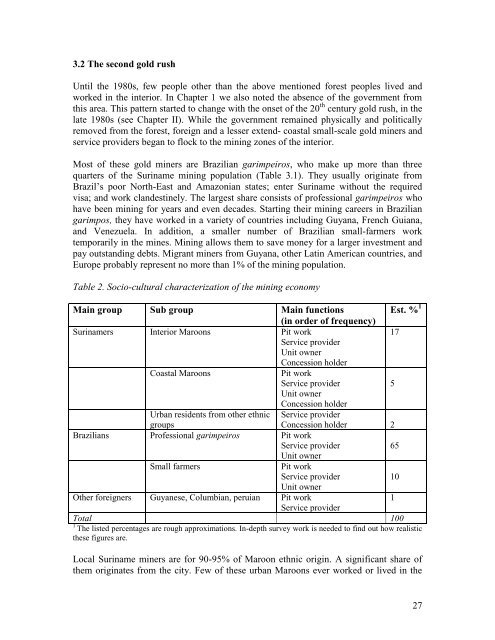SITUATION ANALYSIS OF THE SMALL-SCALE GOLD ... - WWF
SITUATION ANALYSIS OF THE SMALL-SCALE GOLD ... - WWF
SITUATION ANALYSIS OF THE SMALL-SCALE GOLD ... - WWF
Create successful ePaper yourself
Turn your PDF publications into a flip-book with our unique Google optimized e-Paper software.
3.2 The second gold rush<br />
Until the 1980s, few people other than the above mentioned forest peoples lived and<br />
worked in the interior. In Chapter 1 we also noted the absence of the government from<br />
this area. This pattern started to change with the onset of the 20 th century gold rush, in the<br />
late 1980s (see Chapter II). While the government remained physically and politically<br />
removed from the forest, foreign and a lesser extend- coastal small-scale gold miners and<br />
service providers began to flock to the mining zones of the interior.<br />
Most of these gold miners are Brazilian garimpeiros, who make up more than three<br />
quarters of the Suriname mining population (Table 3.1). They usually originate from<br />
Brazil‟s poor North-East and Amazonian states; enter Suriname without the required<br />
visa; and work clandestinely. The largest share consists of professional garimpeiros who<br />
have been mining for years and even decades. Starting their mining careers in Brazilian<br />
garimpos, they have worked in a variety of countries including Guyana, French Guiana,<br />
and Venezuela. In addition, a smaller number of Brazilian small-farmers work<br />
temporarily in the mines. Mining allows them to save money for a larger investment and<br />
pay outstanding debts. Migrant miners from Guyana, other Latin American countries, and<br />
Europe probably represent no more than 1% of the mining population.<br />
Table 2. Socio-cultural characterization of the mining economy<br />
Main group Sub group Main functions<br />
(in order of frequency)<br />
Est. % 1<br />
Surinamers Interior Maroons Pit work<br />
Service provider<br />
Unit owner<br />
Concession holder<br />
17<br />
Coastal Maroons Pit work<br />
Service provider<br />
Unit owner<br />
Concession holder<br />
5<br />
Urban residents from other ethnic Service provider<br />
groups<br />
Concession holder 2<br />
Brazilians Professional garimpeiros Pit work<br />
Service provider<br />
Unit owner<br />
65<br />
Small farmers Pit work<br />
Service provider<br />
Unit owner<br />
10<br />
Other foreigners Guyanese, Columbian, peruian Pit work<br />
Service provider<br />
1<br />
Total 100<br />
1<br />
The listed percentages are rough approximations. In-depth survey work is needed to find out how realistic<br />
these figures are.<br />
Local Suriname miners are for 90-95% of Maroon ethnic origin. A significant share of<br />
them originates from the city. Few of these urban Maroons ever worked or lived in the<br />
27
















